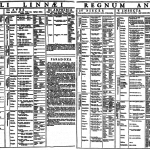 Can you believe June is here? In just a few short weeks the year will be half over. Time does indeed fly when you are having fun. Speaking of having fun, how is your ICD-10 transition plan going? You remember ICD-10, don’t you? Seems like all the news of late has focused on things like the third (and last) stage of meaningful use, the SGR repeal, and that new kid on the block, alternative payment models. But let’s not forget the issue that will single handedly create the greatest disruption in your practice this year, and perhaps this decade: moving from a code set we’ve used for the past 35 years to one that is much more complex.
Can you believe June is here? In just a few short weeks the year will be half over. Time does indeed fly when you are having fun. Speaking of having fun, how is your ICD-10 transition plan going? You remember ICD-10, don’t you? Seems like all the news of late has focused on things like the third (and last) stage of meaningful use, the SGR repeal, and that new kid on the block, alternative payment models. But let’s not forget the issue that will single handedly create the greatest disruption in your practice this year, and perhaps this decade: moving from a code set we’ve used for the past 35 years to one that is much more complex.
By the numbers
By now most of you have heard the basics. Depending on who does the counting, there are approximately 14,000 ICD-9 diagnostic codes and 68,000 ICD-10 diagnostic codes. While the five-fold increase itself is not particularly daunting, think for a moment about how many I-9’s you’ve memorized. For many people this is like that scene in the movie The Matrix where Cypher doesn’t see the code, he sees the matrix. Take, for instance, 585.6, 250.00, and E845.0. These are not random number sequences; they are diseases we treat every day. (Okay, perhaps not E845.0.) That’s about to change as our favorite 4- and 5-digit numerical sequences will soon be replaced by alphanumeric strings, some as long as seven characters.
We’ve been using ICD-9 in this country for over 35 years. In 2009 CMS first announced the plan to move to ICD-10, a code set that’s been in place in other countries since 1992. While the rest of the civilized world has made the transition to 10, we’ve managed to postpone the transition not once, not twice, but three times.
By all indications the party will soon be over. 17 weeks, 114 days, 2,740 hours (give or take), no matter what measure of time sounds less daunting, the ICD-10 train is approaching, and it’s picking up speed.
Impact
In the United States ICD is not being used as its creators intended, which is one of the main reasons we’ve waited so long to transition. The current classification got its start in 1948 when the World Health Organization stepped in to allow measureable classification of diseases worldwide with ICD-6. Roughly 35 years ago CMS, the largest health insurer in the world, began to weave the ICD-9 code set into the fabric of the U.S. health care payment. Naturally every commercial payer followed suit, so today a cousin of the original ICD code set is an integral part of our complex health care economics framework.
The information technology piece of this puzzle is tough enough, but every health IT vendor that’s been around a few years has had a lot of practice prepping for this (thanks to the multitude of postponements). Within this context, I doubt we will see many technical glitches, although we will certainly see a few.
No, the larger impact will likely be at the provider-payer interface (i.e. Will you be paid for the work you do in a timely fashion?) For example, some have suggested the claims denial rate may triple in the months following the transition. Given the focused nature of our specialty, we may not see errors of that magnitude, but many small practices operate month to month on a cash basis. Are they prepared for the cash flow hit this transition may create?
ESRD
As the ICD-10 train approaches, the potential unintended consequences of this transition are also causing some to lose sleep. Last week a colleague brought the planned changes to the 2728 form to my attention. For those of you not involved in the care of the ESRD population, the 2728 form is the CMS form a nephrologist must complete in order for a patient to start outpatient dialysis. The form contains patient demographic data, but importantly it also serves to record the cause of ESRD, along with other co-morbidities the patient may have at the start of dialysis. In the past, some nephrologists glossed over this form and simply applied their “John Henry”. In today’s environment it’s becoming clear our friends at CMS are using some of the data on this form when they calculate quality measures (like the standardized ratios that are part of the QIP and 5-Star programs).
Why bring the 2728 form up you might ask? You should see what they’ve done to this form in preparation for the arrival of the ICD-10 train. Those of you who complete a 2728 today know the diagnosis list is one page in length and populated with familiar ICD-9 codes, many of which you have memorized. The new ICD-10 compatible 2728 has over 4 pages of codes to choose from, including an astonishing 50 unique codes to identify interstitial nephropathy secondary to lead. Really? Making matters worse is the fact that some of the diagnoses that are far more common causes of renal failure did not make the cut. Take a look for yourself (assuming you have the time to peruse literally hundreds of ICD-10 codes on the form).
Light in the tunnel
The light up ahead is indeed the I10 train and it is headed our way. In spite of recent rumblings, it is very unlikely the train’s arrival will be postponed again. Your preparation for the transition should be well underway, and while I firmly believe in the value of preparation, it’s those potential unintended consequences that are always a bit troubling. Are you ready for the transition? Drop us a note and join the conversation.
 Terry Ketchersid, MD, MBA, practiced nephrology for 15 years before spending the past seven years at Acumen focused on the Health IT needs of nephrologists. He currently holds the position of Chief Medical Officer for the Integrated Care Group at Fresenius Medical Care North America where he leverages his passion for Health IT to problem solve the coordination of care for the complex patient population served by the enterprise.
Terry Ketchersid, MD, MBA, practiced nephrology for 15 years before spending the past seven years at Acumen focused on the Health IT needs of nephrologists. He currently holds the position of Chief Medical Officer for the Integrated Care Group at Fresenius Medical Care North America where he leverages his passion for Health IT to problem solve the coordination of care for the complex patient population served by the enterprise.




Leave a Reply